The top 10 knowledge management tools at a glance
3. August 2023
Without a well-structured knowledge base, for example for processes and products, not much can be done in modern companies. Most organizations are well aware of this. When an employee leaves the company, he or she “takes” valuable knowledge with him or her, and the corporation loses it. Ideally, employees can quickly find the information they need in their daily work because their colleagues have documented it in modern systems.
The market is booming
Accordingly, the market for knowledge management and quality management systems has been booming for years, especially for open-source systems. They are ahead of the game in terms of transparency, traceability, security and reliability. These are increasingly important factors, especially when it comes to privacy and compliance. At the same time, the market leader in proprietary systems, the Australian provider Atlassian, is upsetting many customers. It is massively raising prices for Confluence, Jira, and Trello and forcing customers into the cloud despite all the privacy and reliability issues
Good thing there are alternatives. The open source scene has something for everyone – and BlueSpice MediaWiki from Hallo Welt! has been a synonym for professional software with enterprise functions and valuable integrations for many years.
In this comparison we present the best alternatives to Confluence and show their strengths but also their weaknesses. We have selected Bookstack, DokuWiki, MediaWiki, Wiki.Js, XWiki, Foswiki and Q.Wiki, as well as the two lesser-known OpenKM and Outline. The top dog Confluence and our BlueSpice complete the comparison of the top 10. Let’s start in alphabetical order.
BlueSpice
BlueSpice developed by the German company Hallo Welt! is the leading enterprise distribution for MediaWiki (see below). It is completely open source. BlueSpice combines the most important extensions for MediaWiki with previously unavailable, self-developed features, for example, to accelerate work and innovation processes for companies of all sizes.
However, the BlueSpice distribution is not only a collection of extensions. It also brings continuous integration and standardization of the latest MediaWiki software to enterprises. The specifically designed user interface (“skin”) with significantly higher usability compared to the pure MediaWiki and other products comes along with numerous functional unique selling propositions.
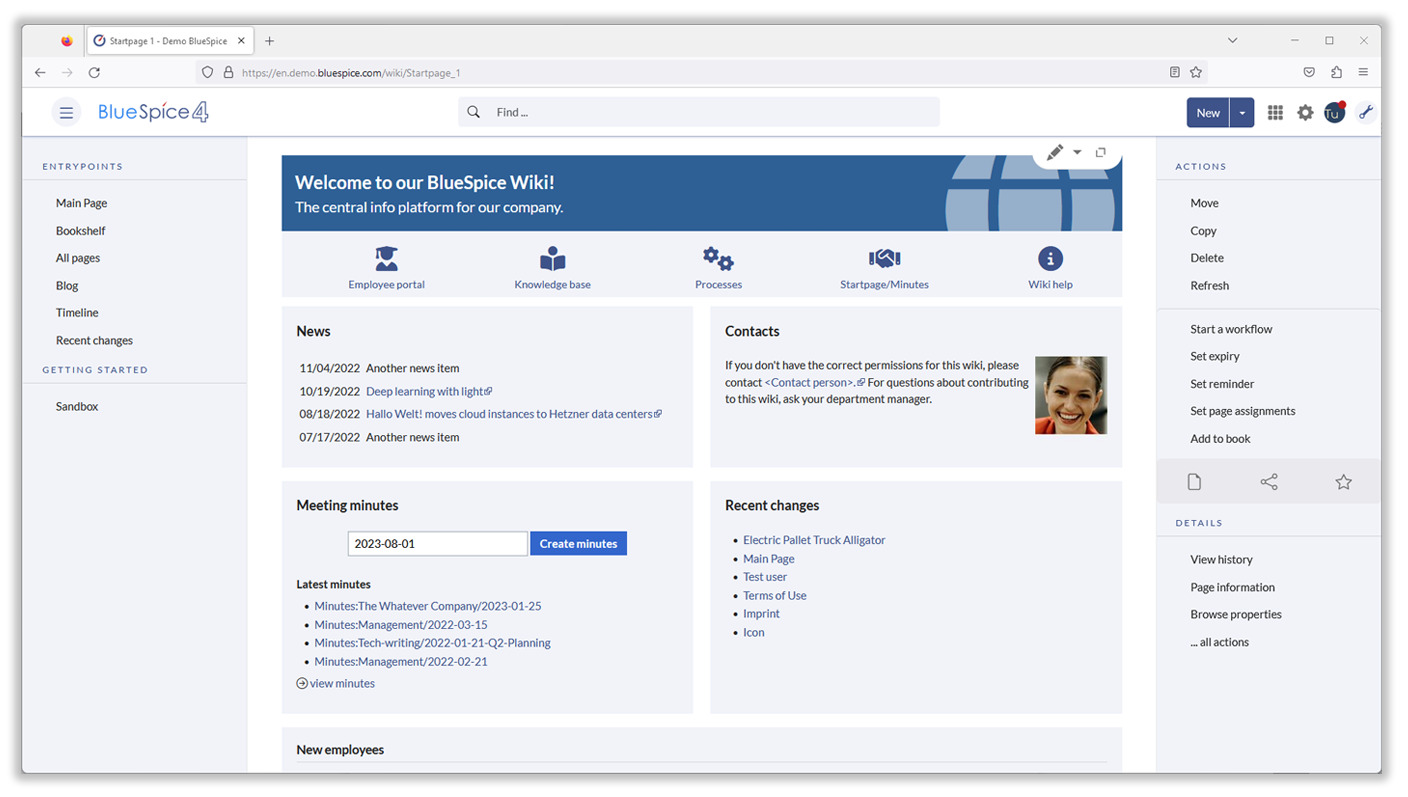
Screenshot 1: BlueSpice offers a clear user interface. You have many options to create your own content. This means that you always have a clear view of exactly what you really need. Get started with the help of templates and droplets.
The user interface allows both the simple administration of rights and user accounts as well as the administration for MediaWiki with a PermissionManager, GroupManager, UserManager and NamespaceManager.
The pro and farm editions add many special functions, for example to support editorial and quality management processes (document control: customizable workflow with release function, update monitoring, reminder function, read confirmation, task function, central category management, editor management), also a book function with hierarchical navigation, book creation via drag & drop and much more. Semantic functions, metadata processing and forms, are included as well as the “social” functions discussions and blog.
BlueSpice is available as a cloud solution, but also as an on-premise version that allows you to implement all the requirements of the GDPR. Hallo Welt! offers personal attention and professional support from the European manufacturer with a special focus on data protection, accessibility and standards compliance. In numerous comparisons in international media, BlueSpice always performs outstandingly.
BookStack
The name BookStack says it all: Like in a real library, the wiki divides knowledge into books, which in turn consist of chapters and individual pages. Books can then be placed on shelves. BookStack integrates diagrams.net, OpenID and other backends (social media), but can’t do branding and enforces the book/shelf structure.
BookStack offers both an intuitive What-You-See-Is-What-You-Get (WYSIWYG) editor and one for the popular markup language Markdown. The latter also has a live preview. The books can be searched and linked paragraph-by-paragraph.
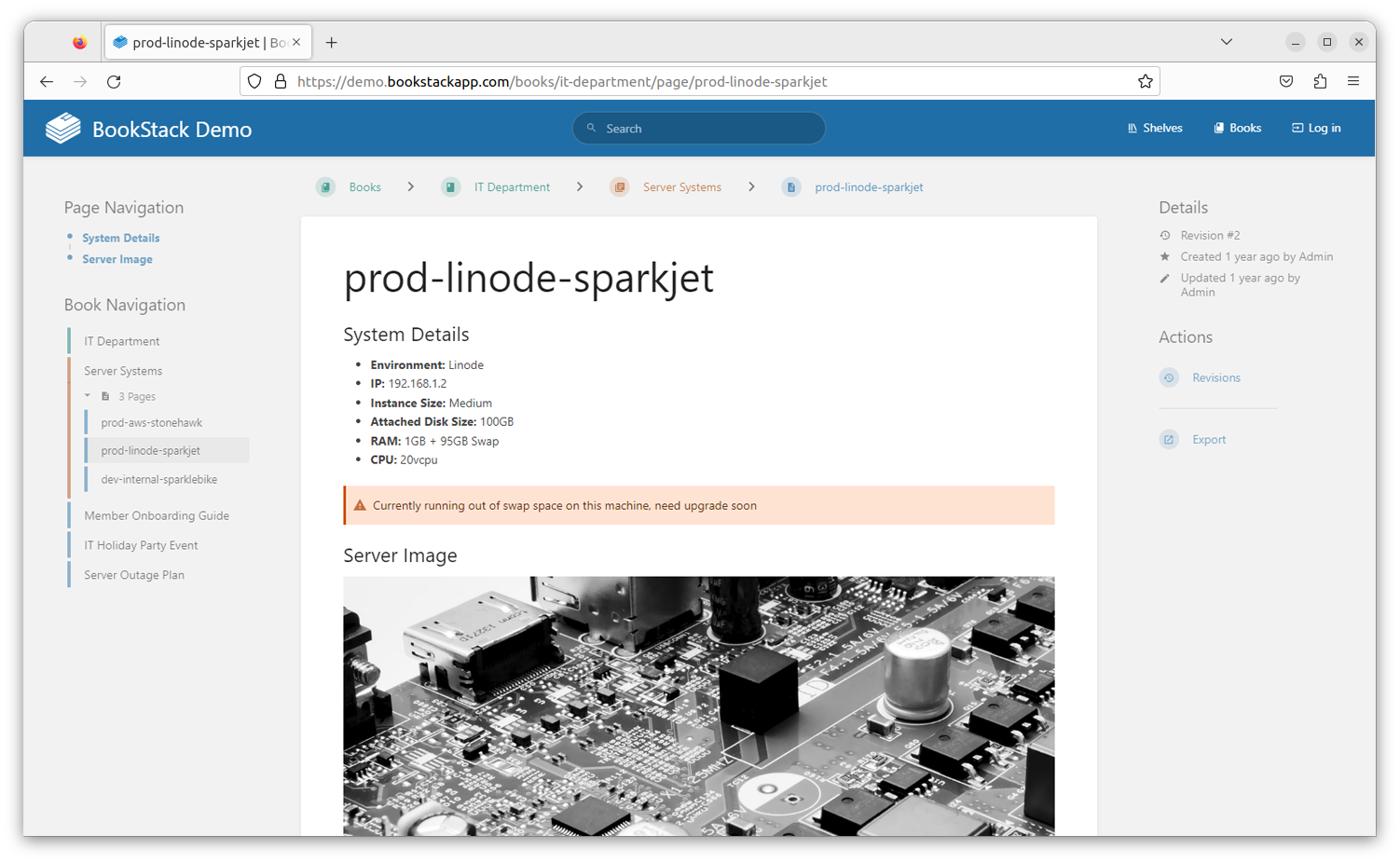
Screenshot 2: Bookstack offers a simple user interface: on the left you choose the content, other functions appear on the right.
Hallo Welt!’s review: We like some of the design ideas and the usability of BookStack. The “book” function is also very important for our customers – but it’s not our main focus because we follow the classification logic of Wikipedia. Our customers need a tool that is easy to use and appealing to employees, but they also have to map very complex documentation tasks. Then, however, easy usability is often no longer enough.
Confluence
The proprietary licensed Confluence from the Australian manufacturer Atlassian is certainly one of the most popular and comprehensive, but also by far the most expensive knowledge management systems on the market.
Confluence manages individual pages, which are in turn in (work) areas, supports access rights, a modern, collaborative editor for up to 12 people at a time, child pages, and numerous macros.
However, Atlassian’s offerings are a big pain for all those who (have to) attach importance to data protection and sovereignty, for example because they are operating in the legal area of the EU or have sensitive data in the company – such as company secrets or personal data of employees. For these customers, the cloud version of Confluence is not suitable, which is the reason why very many of them are currently looking for alternatives. An on-premise installation is possible, but much more expensive than the cloud solution, especially for small companies.
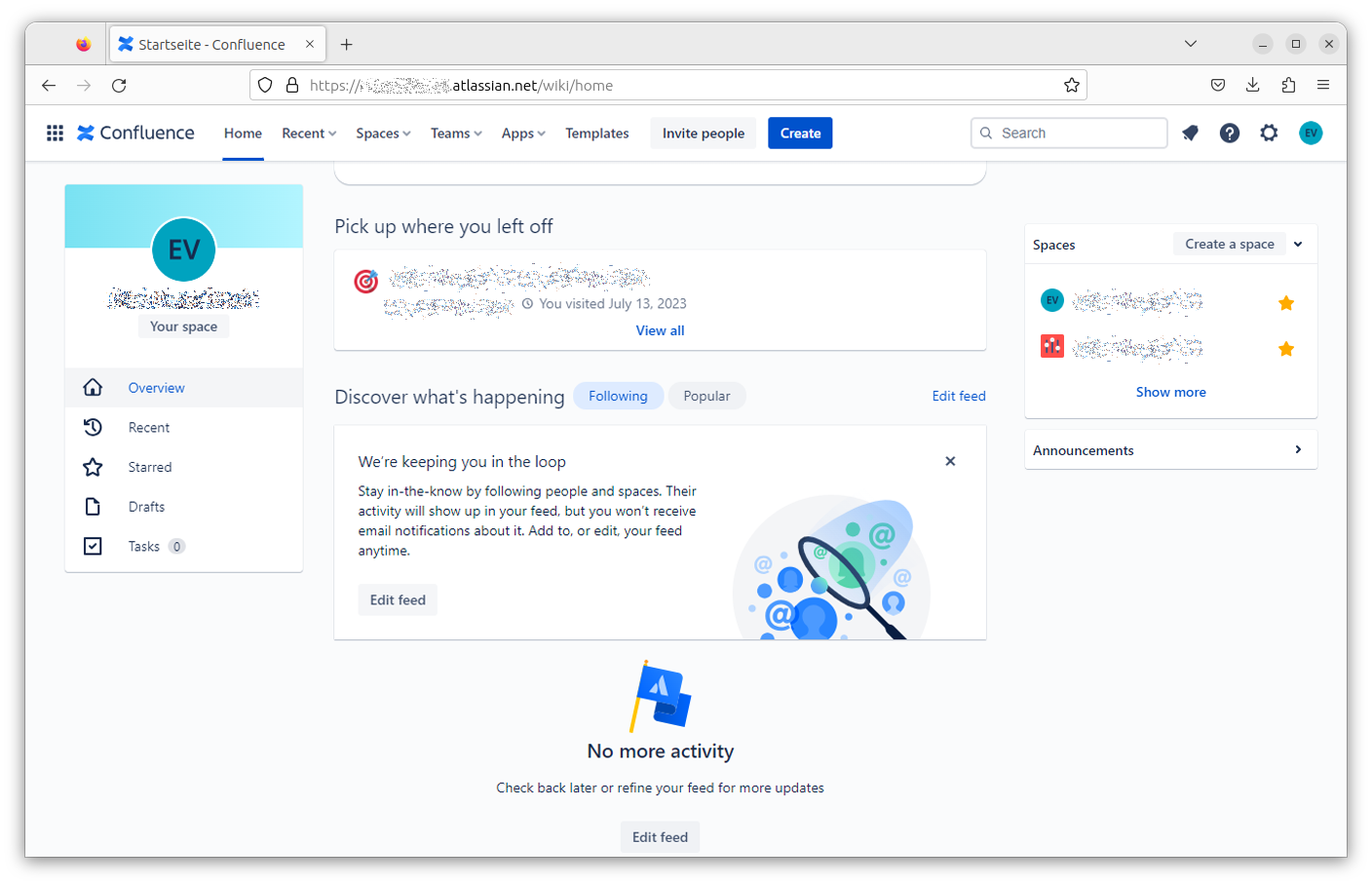
Screenshot 3: In the central Confluence dashboard, the user can clearly see what has been done.
Hallo Welt!’s review: Confluence has a large ecosystem, but it is very expensive and not really intended as a wiki. The basic structure, in which more “Spaces” can be created very quickly, leads to countless knowledge silos that should be instead broken up with the wiki approach. Atlassian and Confluence tend to follow the Microsoft model: functions are specified by the manufacturer. MediaWiki and BlueSpice are much more agile and typically open source. This is one of the reasons why BlueSpice already has more functions on board in the standard version.
DokuWiki
With DokuWiki, the content does not end up in a database as with the other candidates, but in plain text files. Each file later corresponds to a web page, and several pages can be grouped or categorized via namespaces. Each file later corresponds to a web page, and several pages can be grouped or categorized via namespaces. The page management takes some getting used to, and a structured table of contents is also missing.
DokuWiki can quickly generate presentations and other output and comes with extensive version management and rule-based access authorization. Functions like authentication with an LDAP server and comments can be upgraded via plugins.
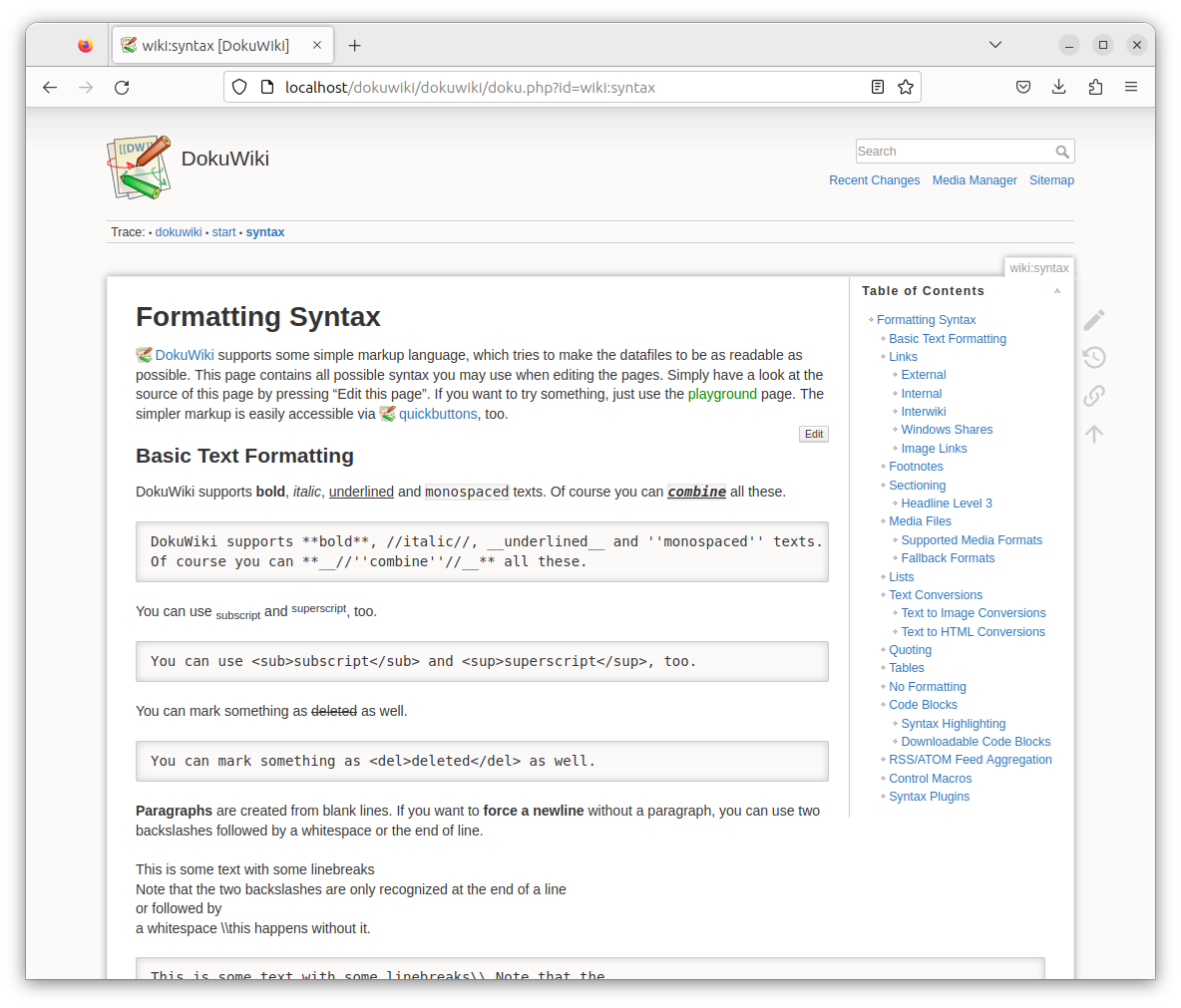
Screenshot 4: DokuWiki has its own markup formatting language and can handle numerous extensions, for example for presentations.
Hallo Welt!’s review: DokuWiki is a very likable project that, like BookStack, is very focused and simple. However, the decision to work without a database and only with plain text takes the project a bit away from typical enterprise requirements.
Foswiki / Q.Wiki
TWiki has been a cornerstone of the wiki software world since 1998. Even though work on the project is currently on hold, it formed the basis for no less than two other wiki systems. One is the commercial Q.Wiki, which is available exclusively as a cloud service. The operator of Q.Wiki, Modell Aachen GmbH, has expanded TWiki for use as a management system and its solution is used by Bosch, Siemens and Unicef, among others.
The other is the free fork Foswiki. Support here is provided exclusively by the community via chat, Slack and mailing lists.
Foswiki manages knowledge on individual pages that can be grouped thematically in so-called webs. If you switch off the visual TinyMCE editor, you can specify the formatting in the in-house Topic Markup Language. In addition, users can specify individual pages for notifications. The wiki will automatically inform them about changes via mail. The look and feel of the wiki can be extensively customized using macros and templates.
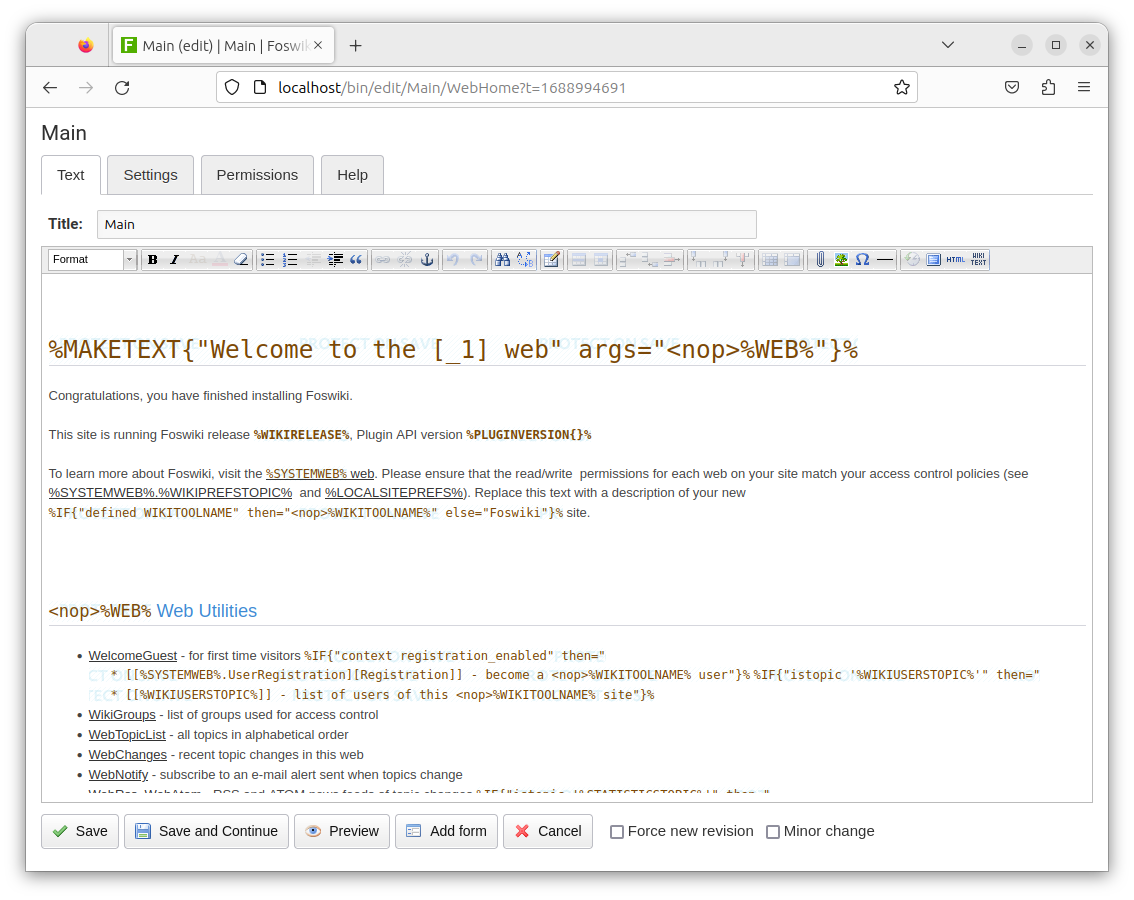
Screenshot 5: Foswiki is a fork of the wiki veteran TWiki and brings its own formatting language.
Hallo Welt!’s review: A fork of TWiki also inherits its architecture. The very powerful tool suffers in many places from dusty technology – which is already evident in the article names (keyword CamelCase). Installation and configuration require technical understanding, ideally in Perl. In addition, MediaWiki and other solutions offer the user significantly more, for example, flexible templates. Other solutions therefore often receive better acceptance from admins and users.
MediaWiki
MediaWiki proves its great power every day as the backbone of the Internet encyclopedia Wikipedia, the fifth largest website in the world. As a result, the software is excellent for very large projects with many simultaneous requests and an encyclopedic structure.
MediaWiki is constantly being further developed under the umbrella of the non-profit Wikimedia Foundation, but users are responsible for installing and operating MediaWiki themselves and are largely on their own. Support is only available from the community of users in forums, chats, and on the official mailing lists. External service providers offer their services for this purpose.
The legacy of Wikipedia is evident in many places: Each article has a special page where the authors discuss the content. Users can also put particularly interesting articles on a watchlist and thus have them monitored by MediaWiki. Another page logs all modifications made to an article. User administration is done by default via five predefined roles with different rights, which also reflect the descent from the online encyclopedia. A minimal quality assurance function is also possible: using a plugin MediaWiki will only release a text after it has been reviewed by a counter-reader – as in Wikipedia.
Thanks to the popularity of MediaWiki, there are numerous extensions that increase the functionality in various directions. However, a noticeable number of extensions from the official catalog are no longer being developed. The integration of the wiki into your own software is done optionally via a PHP or REST interface.
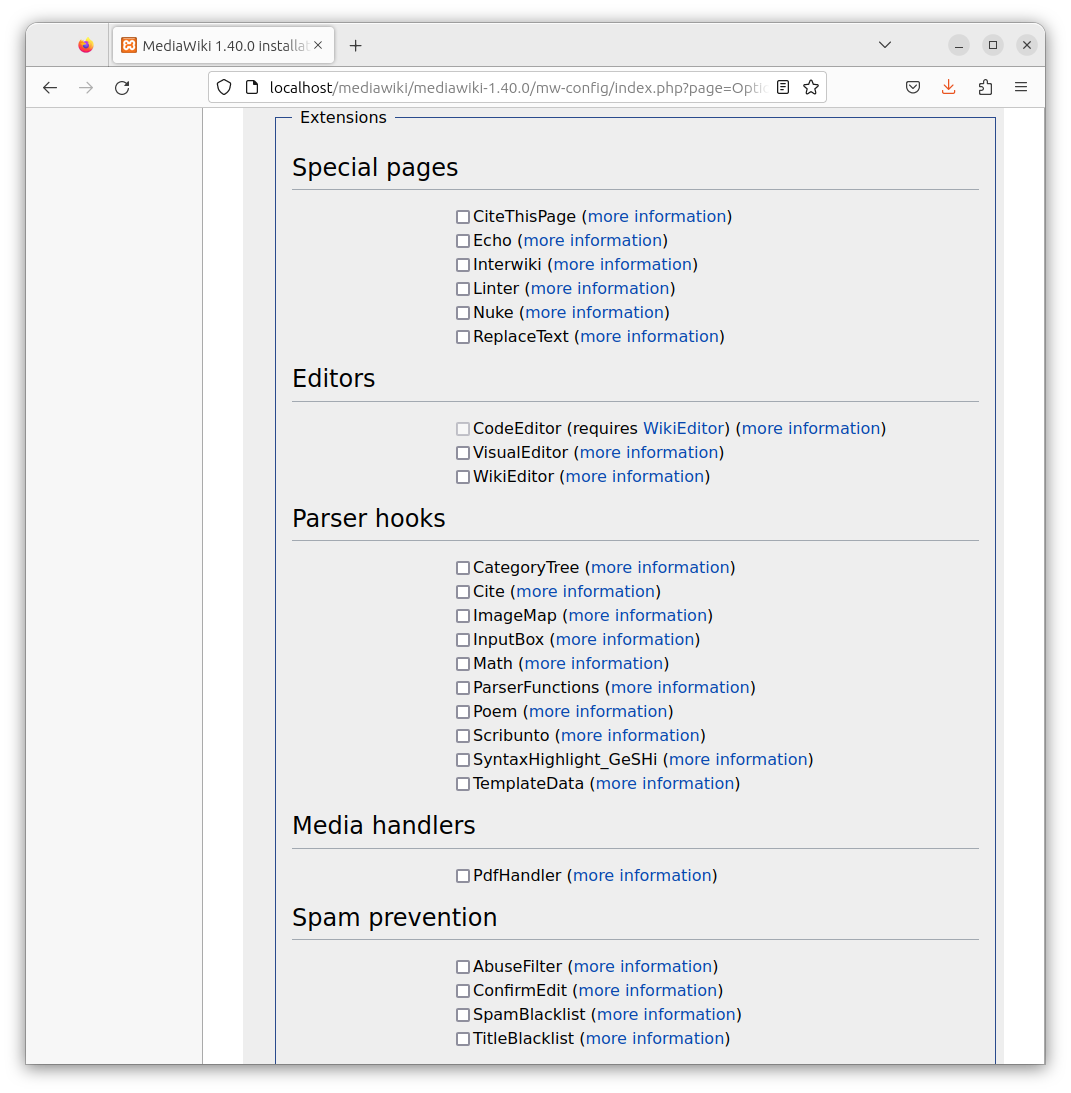
Screenshot 6: The software behind Wikipedia is called MediaWiki. Its feature set is optimized for the operation of the famous knowledge platform.
Hallo Welt!’s review: MediaWiki is not intended for enterprise use, nor is there any development or maintenance for mission-critical features. MediaWiki is tailor-made for Wikipedia instances and does not focus on usability for admins and does not offer any enterprise services. This is another reason why for many years there are Hallo Welt! GmbH and other MediaWiki service providers. For the MediaWiki communities the free community distribution Canasta might be of interest.
OpenKM
OpenKM, originally a document archiving solution from Mallorca, is actually an exotic product in this comparison because it is not a wiki – it only knows a wiki extension. However, the manufacturer explicitly advertises this on the website, and OpenKM is also suitable as a knowledge repository and can refer to several large customers: In Germany, OpenKM is used by ARD, Leika and the Westphalian University, among others.
OpenKM accepts any type of document, as is usual with document management systems. The software even supports drag-and-drop from the desktop. Suitable add-ins integrate OpenKM with Microsoft Office and LibreOffice. The attached keywords classify the documents, that OpenKM stores encrypted on the server. In addition, the commercial versions explicitly offer a knowledge base module, which collects further knowledge in the form of a wiki. OpenKM shines with workflows and processes that the Java tool brings along, as well as a built-in chat system.
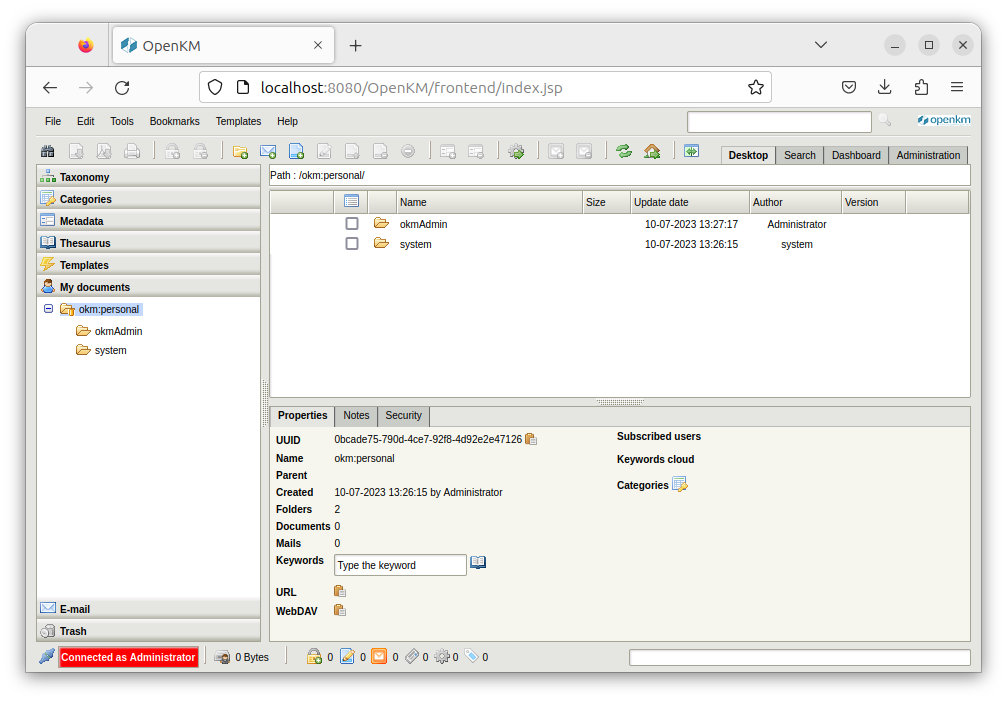
Screenshot 7: OpenKM has a somewhat old-fashioned Java interface.
Hallo Welt!’ review: OpenKM is not a wiki but follows its own structures and ideas. The interface takes some getting used to, but it serves its purpose. However, it has little in common with the dynamics of modern wiki systems.
Outline
The California-based company Outline offers its wiki in a free community version as well as a commercial enterprise edition. Only the latter offers author login via SAML 2, migration from Confluence, an audit log, and support. The developers have trimmed Outline for speed. The response times should be in the millisecond range.
Outline operates with documents that can be nested in any way. In addition, documents can be grouped in so-called collections. Thanks to the help of so-called slash commands, you don’t even have to take your fingers off the keyboard when formatting.
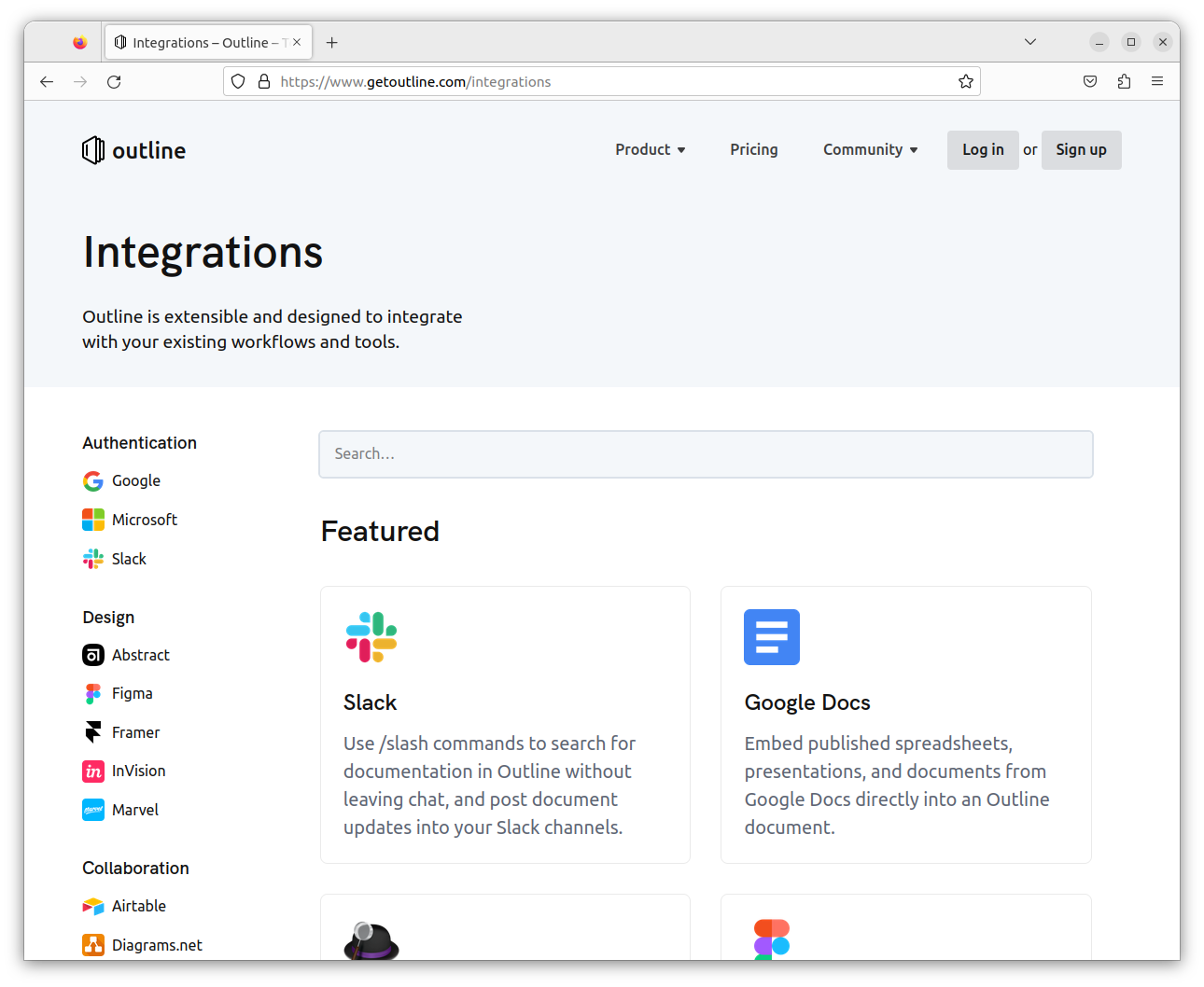
Screenshot 8: Outline shines especially with the integration of common cloud services like Slack and Google, for example for authentication, but also Office files.
Hallo Welt!’s review: Outline offers interesting approaches, such as nesting documents and many connectivity options. However, many features are only available in the enterprise version, e.g. authentication with SAML2, which is important for many companies. Outline has many good ideas, but appears limited in terms of customization and is designed for speed.
Wiki.Js
Developer Requarks.io has also optimized its Wiki.js for speed. In addition, the software is supposed to scale very well. Among other things, it officially supports operation in Kubernetes. Those who need a particularly powerful search can use Elasticsearch or cloud services such as Algolia or Azure Search. Wiki content can also be synchronized with various cloud storage. The appearance of the wiki can be customized in principle via design templates (themes), but not yet with a mouse click.
The wiki can also be authenticated via SAML, Azure AD, OAuth2 and OpenID Connect, among others. Also possible is a single sign-on via the accounts of various social media services, including Google, Facebook, Microsoft, GitHub, Discord and Slack. Additional security is provided by two-factor authentication if desired. Wiki.js can be integrated into the user’s own systems via a GraphQL interface and custom modules.
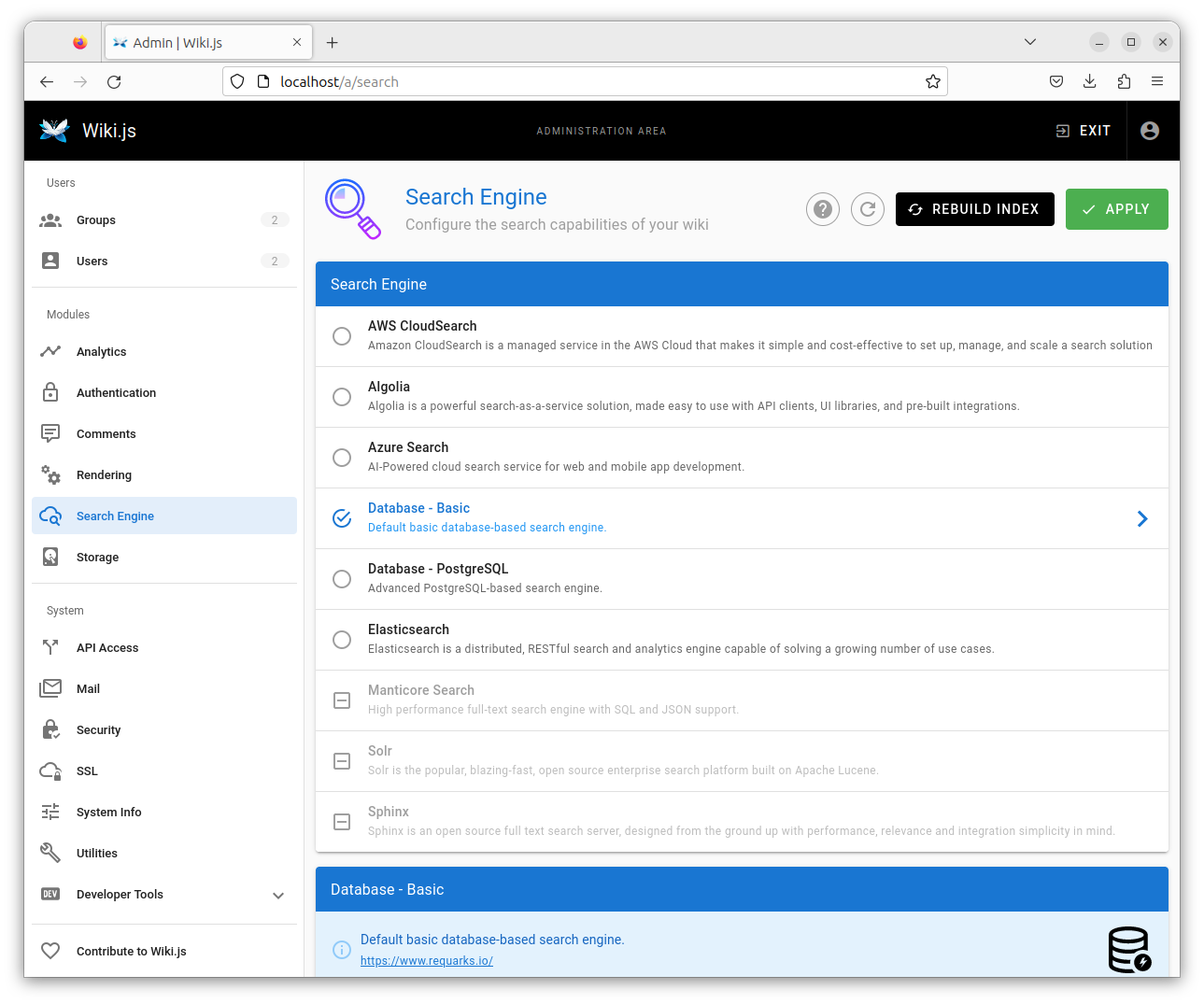
Screenshot 9: Wiki.js allows the admin to choose from different search engines – with just a single mouse click.
Hallo Welt!’s review: Wiki.js has many similarities with projects like BookStack and DokuWiki. Wiki.js was created as a pure community project by people who like to work with JavaScript. The feature set is generally not sufficient for use in companies, but these are presumably not the target group of its developers.
XWiki
Ludovic Dubost published the first version of his XWiki back in 2004. In the meantime, he founded the company XWiki SAS, which is largely responsible for the further development. According to its own information, customers include Amazon and the French railroad SNCF. The manufacturer actively promotes its wiki as an alternative to Confluence and MediaWiki.
XWiki is open source. Companies are likely to use the particularly long-maintained version with Long Term Support (LTS). Many useful functions can be retrofitted with extensions (e.g. OpenID and LDAP). In contrast to many competitors, XWiki also allows admins to specify the structure of a page. For example, it can be specified that the page title is always followed by a date.
The French company is also developing several commercial XWiki variants with enhanced functionality, such as XWiki Pro. This variant adds important functions, especially for companies, such as single sign-on with Microsoft’s Azure Active Directory.
XWiki serves not only as a pure knowledge base, but also as a basis for new web applications (“Second Generation Wiki”), such as the peer-to-peer office software Cryptpad.
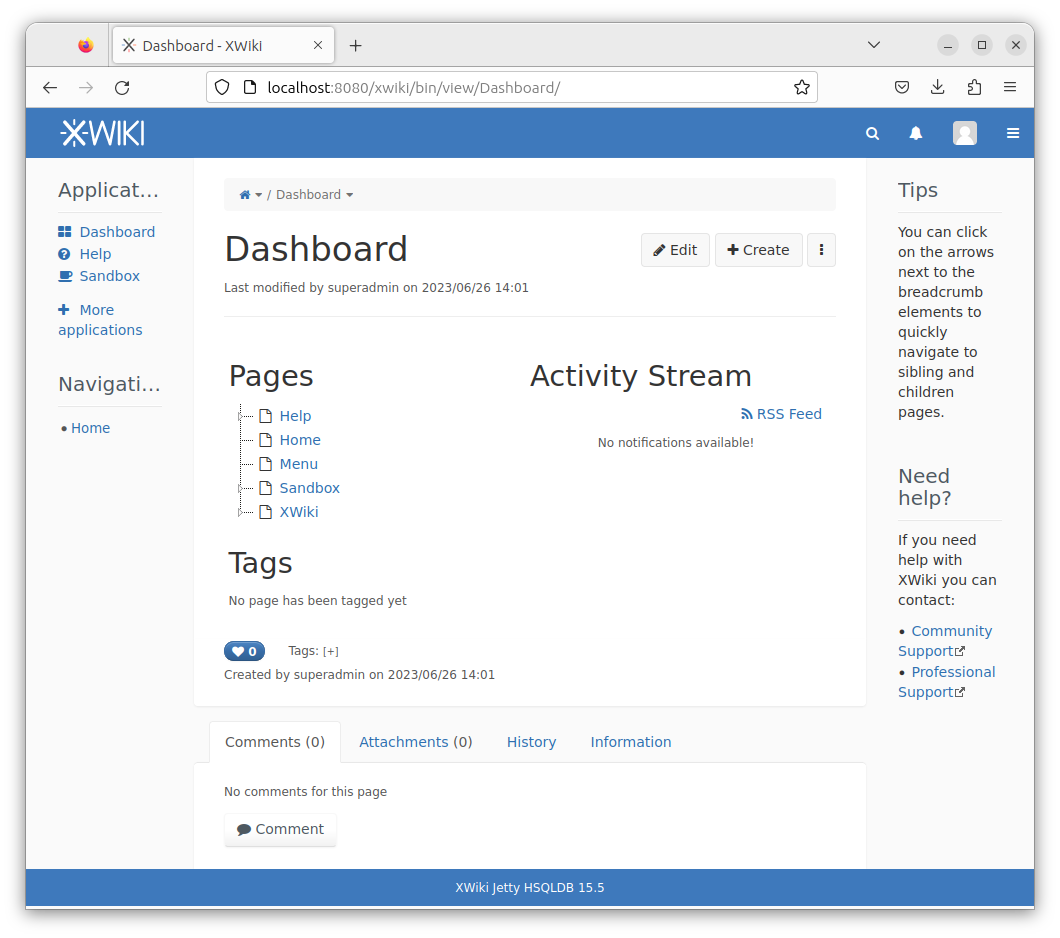
Screenshot 10: XWiki, which originates from France, knows activity streams and can handle tags.
Hallo Welt!’s review: XWiki is a versatile software with its own innovations. However, like Confluence and OpenKM, it is written in Java and has no semantics. Design and technology seem outdated to more than a few. Design may be an issue, but the developers of XWiki have created a remarkable product in any case. However, we see MediaWiki – not least with Wikipedia in the background – as having the more interesting and long-term development prospects.
Hallo Welt! GmbH is the company behind the open-source enterprise wiki software BlueSpice, which is distributed in more than 160 countries with over 1 million downloads. The Regensburg-based company builds collaborative software for knowledge management and online documentation since 2007.
Authors: TS/MF
Share This Story, Choose Your Platform!
| Except where otherwise noted, news on this site is licensed under a Creative Commons Attribution 4.0 International license. |
More BlueSpice News
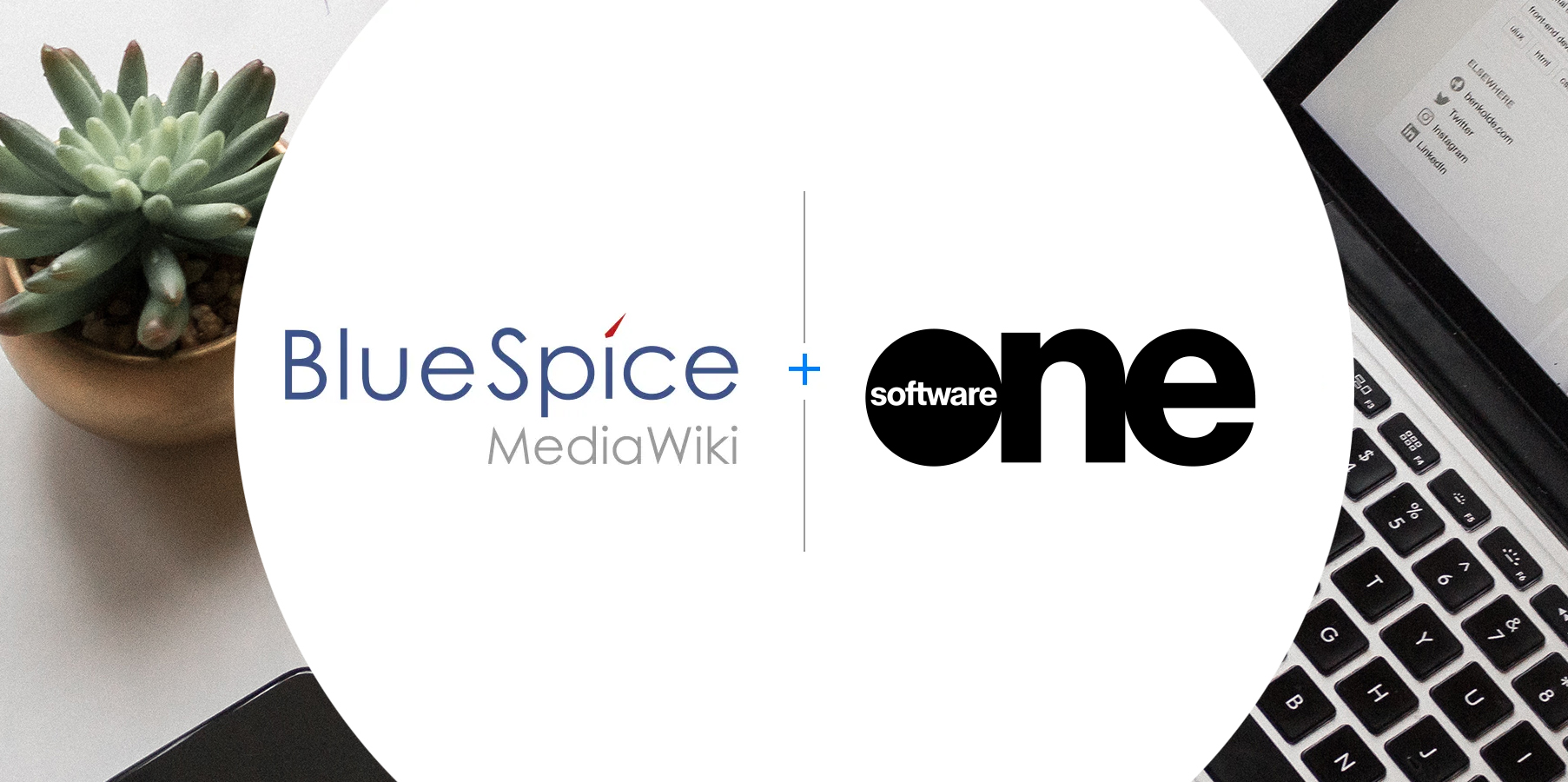
Get BlueSpice easily via SoftwareOne
23. July 2024
Start your BlueSpice wiki now via SoftwareOne thanks to our new partnership.
Read more
+
Here comes BlueSpice 4.5
16. July 2024
BlueSpice 4.5 brightens up your summer with hot new features like AI Assistant or CollabPad.
Read more
+
Hallo Welt! GmbH publishes audit report for BSI C5 criteria catalog
6. May 2024
Hallo Welt! GmbH publishes the first BlueSpice Cloud audit report for the BSI C5 criteria catalog for secure cloud services.
Read more
+



